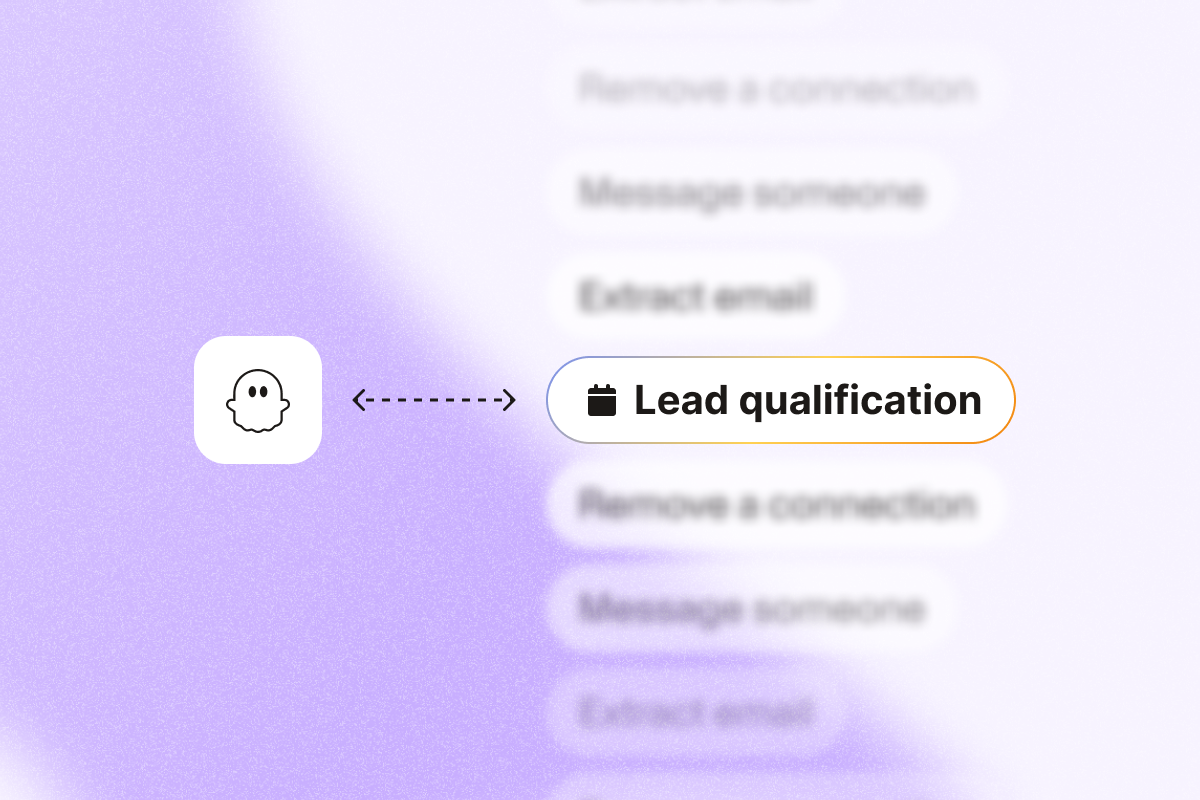Lead qualification helps you identify the prospects most likely to become customers.
When combined with lead enrichment, lead qualification keeps your sales team on track and increases your chances of closing deals.
In this guide, we cover what lead qualification is, why it matters, and how to make it a natural part of your lead-generation process.
TL;DR
- Lead qualification lets you focus on prospects who are more likely to convert, improves efficiency, and increases your chances of closing deals.
- Qualified leads fit your Ideal Customer Profile (ICP) and show interest in your product, while unqualified leads lack fit or interest, lowering their chances of becoming paying customers.
- Qualified leads can originate from marketing (MQLs), sales (SQLs), or product (PQLs) interactions.
- Lead qualification helps marketing and sales teams focus on high-potential leads, improve efficiency, and increase conversion rates.
- Here’s how to build an effective lead qualification process:
- Identify your ICP: Define your ideal customer based on factors such as company size and industry.
- Set relevant criteria: Use specific standards (e.g., engagement, job title) to qualify leads.
- Enrich your leads: Use lead enrichment tools to gather key contact info like job title and location.
- Score leads: Assign scores to prioritize high-potential prospects. AI can help here!
- Qualify in sales calls: Confirm fit through direct conversations about needs, budget, and timeline.
- Several popular lead qualification frameworks, like BANT and CHAMP, provide structured ways to assess which leads are worth pursuing in your sales process.
- We recommend using tools like PhantomBuster to automate lead enrichment, scrape LinkedIn profiles for deeper insights, and create a lead scoring system. This will give your sales reps the tools they need to qualify and prioritize leads more effectively.
What is lead qualification?
Lead qualification helps you determine which potential buyers deserve your time.
Instead of reaching out to every lead that comes through, you focus on those qualified prospects who truly fit your product or service.
A solid lead qualification process provides a clear path, increases efficiency, and improves your chances of closing deals with the right prospects.
It filters out leads who don’t fit, so you direct your energy toward high-quality prospects and create a smoother, more effective sales pipeline.
Qualified leads vs. unqualified leads
Qualified and unqualified leads differ in two main ways: fit and interest.
- Qualified leads match your Ideal Customer Profile (ICP) and show genuine interest in what you offer. They are more likely to convert because they have the right needs, budget, and decision-making authority.
- Unqualified leads don’t fit your ICP or lack sufficient interest. They may not need your solution or may lack the budget or authority to proceed with a purchasing decision.
When you focus on qualified and promising leads, your time and resources go to the best opportunities, making your sales efforts more effective.
Common types of qualified leads
Not all qualified leads look the same.
Different types of leads show different levels of engagement and interest, which helps you decide how to move them through the sales process.
Here’s a breakdown of the main types and what they typically look like.
Marketing qualified leads
Marketing-qualified leads (MQLs) show interest in your business through specific marketing actions.
They might engage with your content, such as downloading an e-book, signing up for a webinar, or filling out a form. While they aren’t ready to buy yet, their actions suggest potential interest in your product or service.
MQLs are usually the first stage of qualified sales leads, requiring more nurturing before they become sales-ready leads.
Sales qualified leads
Sales-qualified leads (SQLs) take engagement a step further.
These leads have demonstrated a clear interest in speaking to your sales reps, either through direct contact (like requesting a demo) or by interacting with sales-focused content on your site.
SQLs meet the criteria your sales and marketing team set for a lead who is ready for direct outreach. They have moved beyond general interest and now show signs of considering a purchase.
Product qualified leads
Product-qualified leads (PQLs) interact directly with your product, often through a free trial or freemium version.
Their actions within the product—such as using key features or engaging frequently—suggest a strong interest in upgrading or purchasing.
PQLs are especially relevant for SaaS businesses, as they give insight into how likely a lead is to convert based on real product usage.
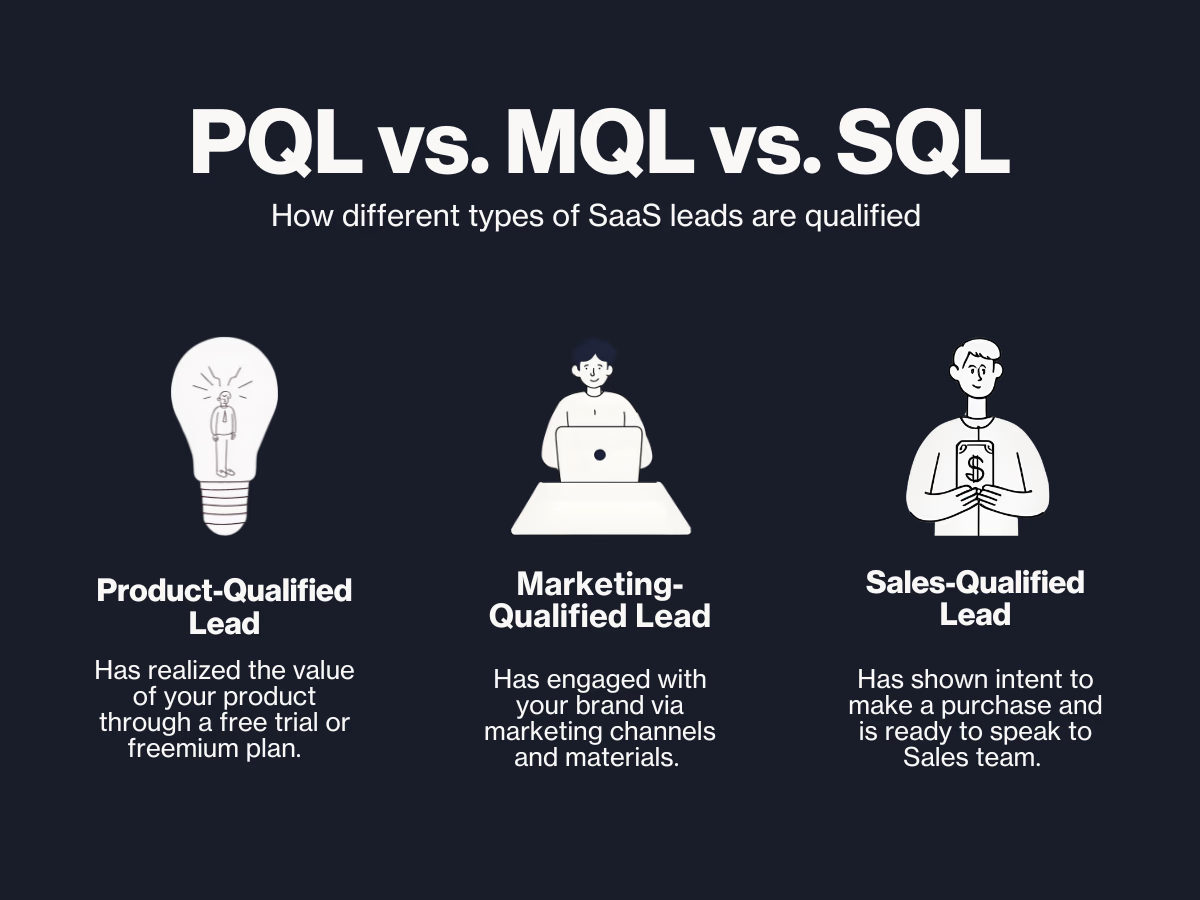
Lead qualification vs. lead scoring
Both lead scoring and lead qualification efforts help you identify the best prospects, but they serve different purposes in the sales process.
- Lead qualification evaluates if a lead fits your ICP and shows genuine interest in your product or service. It determines whether a lead deserves further attention from your sales team.
- Lead scoring assigns a numerical value to each lead based on their actions and attributes, like visiting your pricing page or having a high-level job title. This score helps you prioritize qualifying leads based on how ready they seem to buy.
In short, lead scoring often supports the qualification process. Scores make sorting and ranking leads easier, guiding your team toward the ones with the highest potential.
Why should marketing and sales teams qualify leads?
Lead qualification makes a huge difference in the effectiveness of your lead-generation process.
When teams qualify leads, they direct their resources toward the right people, increasing efficiency and the chances of success.
Here’s why this process matters:
- Targets the right audience: Focuses efforts on leads who fit your ideal profile.
- Increases conversion rates: Improves chances of converting high-potential leads.
- Shortens the sales cycle: Speeds up the process with genuinely interested leads.
- Optimizes resources: Helps sales and marketing teams avoid low-quality leads and prioritize valuable prospects.
- Aligns marketing and sales: Makes sure everyone’s focused on high-quality leads.
Lead qualification isn’t just about filtering contacts—it builds a more efficient, targeted approach that helps your team close deals faster.
Lead qualification process: How to qualify a lead?
Lead qualifying involves a few steps to ensure your team focuses on the right people.
Here’s how to build an effective lead qualification process.
Step 1: Identify your ICP
Your Ideal Customer Profile (ICP) defines the type of customer who benefits most from your product or service.
Knowing your ICP allows you to target leads that best fit your solution, which improves the chances of successful outcomes.
To define your ICP:
- Focus on key characteristics like company size, industry, and location.
- Look at past customers with high satisfaction and retention.
Step 2: Define lead qualification criteria
With your ICP in place, establish specific criteria to qualify leads.
These criteria clarify when a lead meets the standard for moving to the next stage—whether as a Marketing Qualified Lead (MQL) or a Sales Qualified Lead (SQL).
Here are some quick examples:
- Engagement level: Actions like downloading an e-book or attending a webinar may qualify as MQLs. SQLs might include leads who visit your pricing page or request a demo.
- Company size: For small-business solutions, target leads from companies with fewer than 50 employees. For enterprise solutions, prioritize companies with over 500 employees.
- Industry: Focus on industries that align with your product. If you serve healthcare, prioritize leads from healthcare organizations over unrelated sectors.
- Role and decision-making power: If your product requires executive buy-in, look for leads with titles like “Director” or “VP.” Managers might qualify as MQLs but may lack purchasing authority.
- Budget: Qualify leads who fit your pricing range. For example, if your product costs $10,000 annually, leads from companies with small budgets may not qualify.
- Geographic location: If you serve a specific region, like North America, prioritize leads based in that area.
Clear criteria keep your team aligned and make the transition from marketing to sales easier.
Step 3: Enrich your leads with valuable insights
Accurate information on each lead gives you the foundation needed to qualify and segment them effectively.
With the right data, you can start an automated qualification process that segments leads based on specific criteria.
We recommend you use automations like the LinkedIn Profile Scraper to simplify this step.
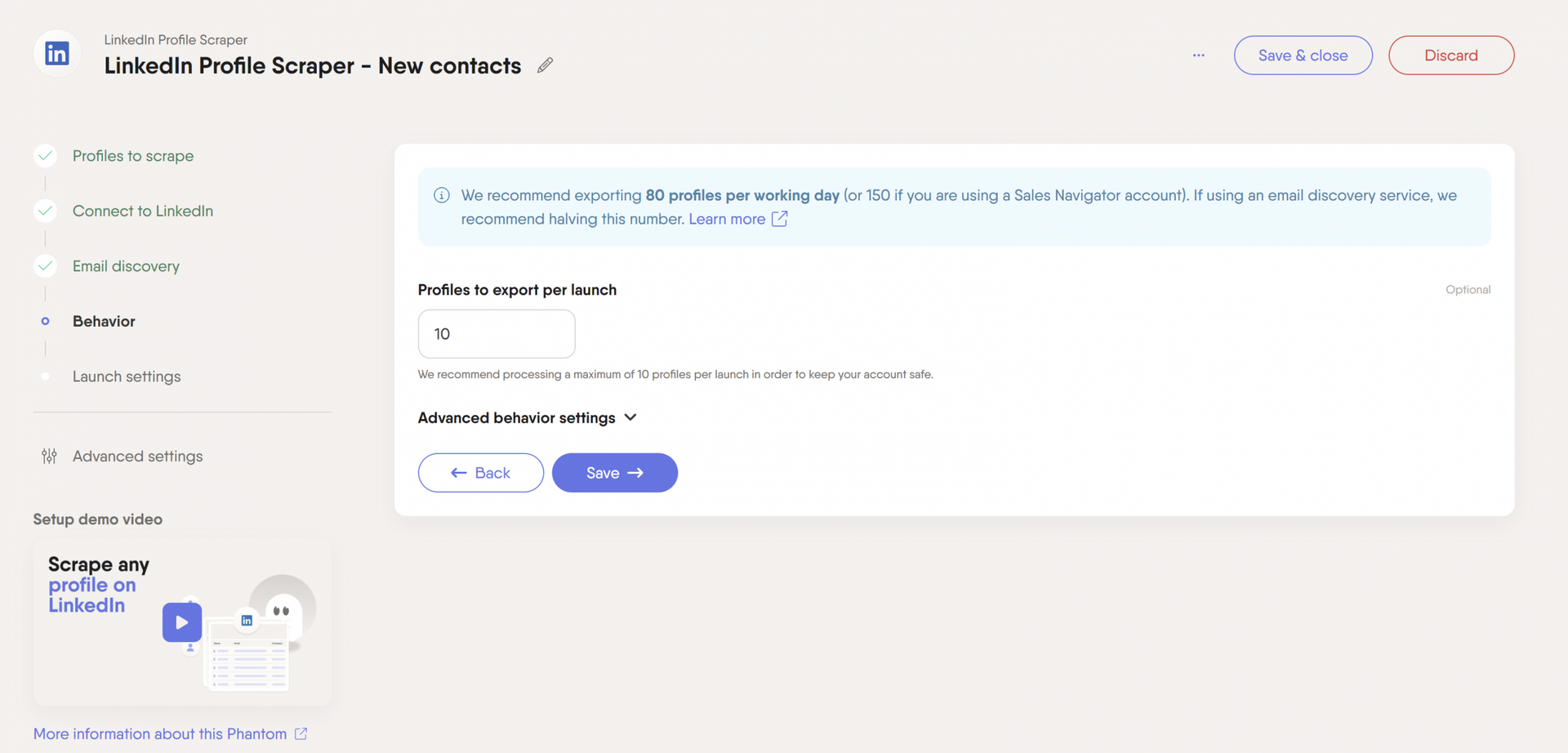
It gathers key information, including:
- Job title and company: Identify the lead’s role and where they work.
- Location: Confirm if the lead aligns with your target geographic region.
- Experience and skills: Assess relevant background and expertise that match your product or service.
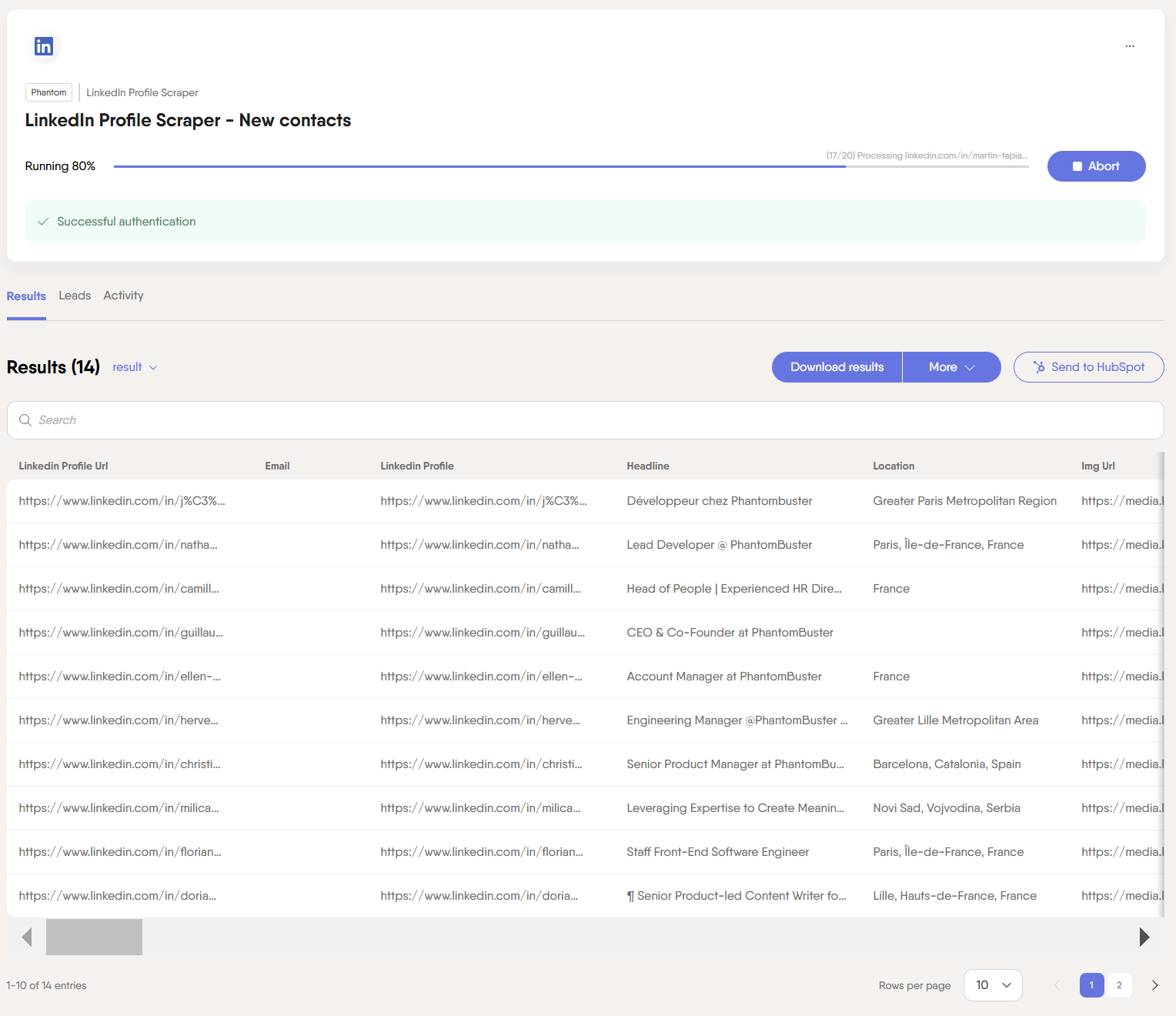
Step 4: Score leads based on relevant criteria
Lead scoring gives your team a clear, structured way to prioritize leads. It ranks leads according to their perceived value or likelihood to convert.
Luckily, predictive AI-powered lead scoring can help!
For example, with PhantomBuster’s AI LinkedIn Profile Enricher, you can add value to your lead-scoring process by enriching each profile with AI-driven insights.
Instead of relying on basic data, it analyzes details that matter to your business, like a lead’s job or decision-making authority.
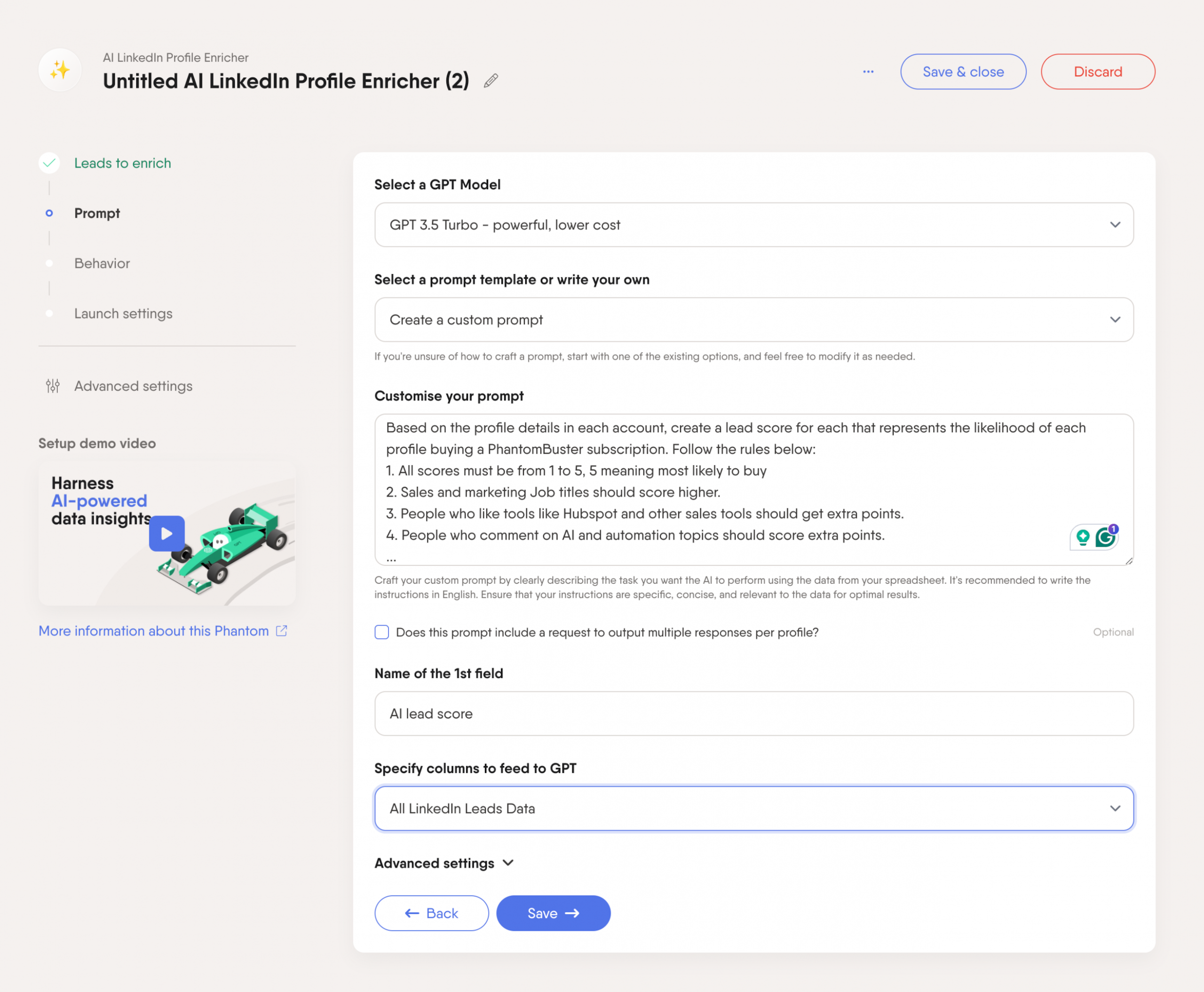
You can customize the prompt based on what matters most to your business.
This extra layer of lead intelligence gives your team a complete picture, enabling them to score leads more accurately and identify the best opportunities faster.
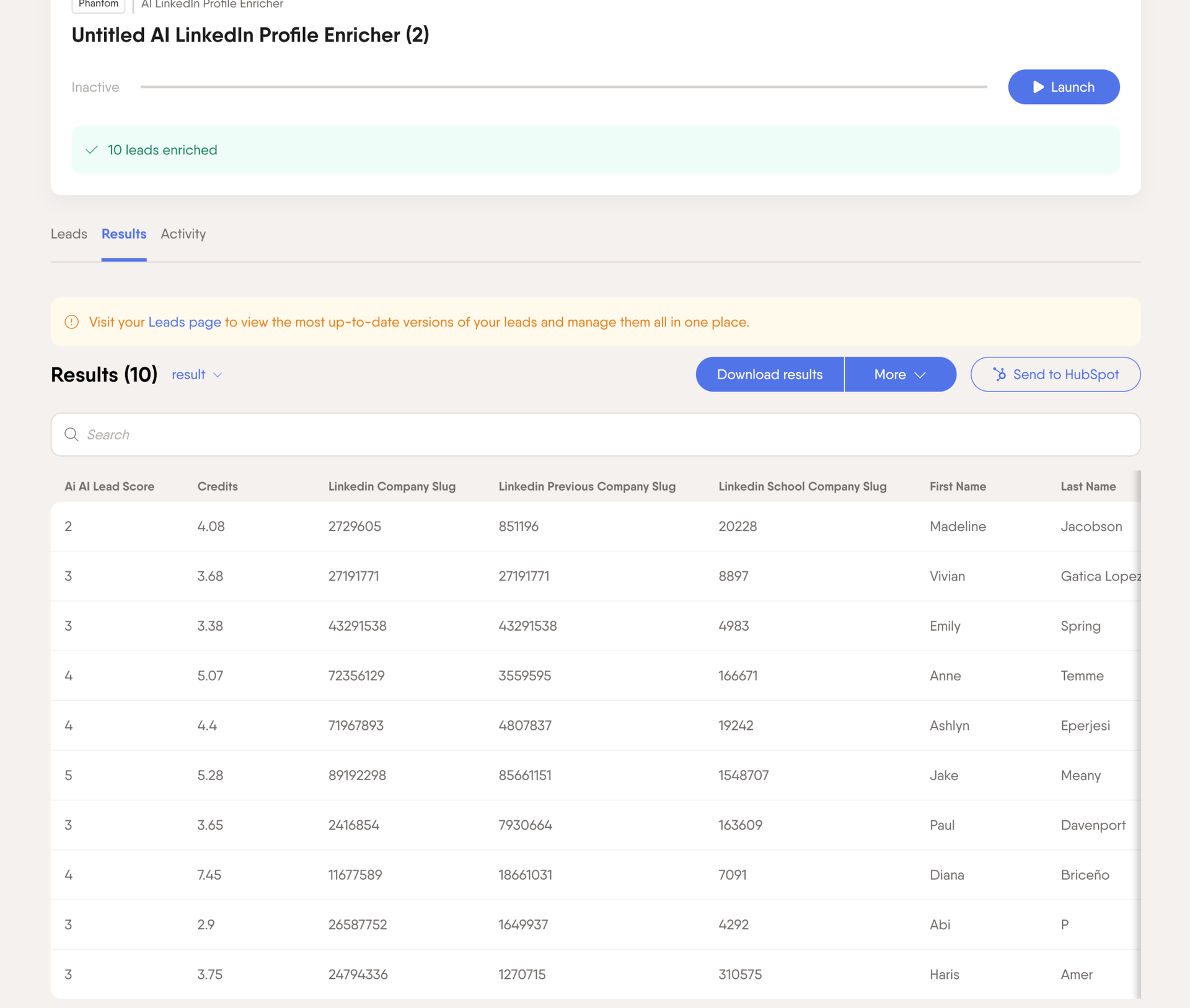
Step 5: Qualify your leads manually during your initial sales calls
This step usually takes place after a lead has filled out a form—like a demo request—and passed through basic automated qualification.
The goal is to dig deeper and uncover details that automated tools can’t provide.
Ask questions to understand their specific needs, timeline, budget, and overall goals.
This conversation helps you gauge how urgently they need a solution and whether they’re ready to move forward, giving you the information needed to decide if they’re a strong fit.
4 Lead qualification frameworks to enhance your lead qualification process
Lead qualification frameworks give you a simple, structured way to determine which leads are worth your time.
Let’s go over four popular ones and how each can help.
Lead qualification using BANT
BANT is a popular lead qualification framework, standing for Budget, Authority, Need, and Timeline.
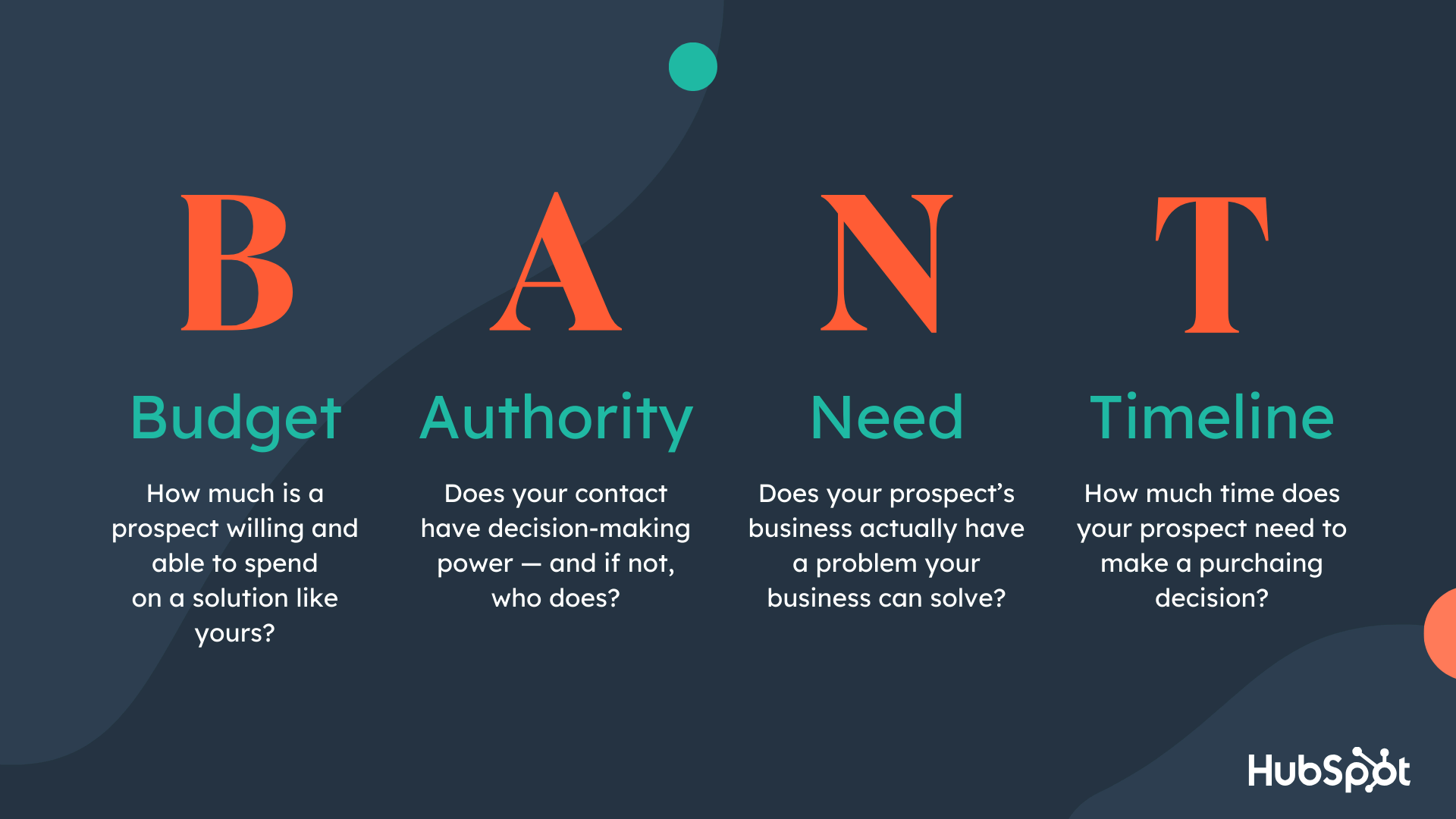
It’s a classic way to check if a lead has what it takes to move forward:
- Budget: Can they afford what you’re offering?
- Authority: Are you talking to someone who can make decisions?
- Need: Do they have a problem your solution solves?
- Timeline: Are they ready to act soon, or is this more long-term?
BANT is great for quick wins, especially if you’re working with shorter sales cycles.
It’s straightforward but doesn’t always catch the bigger picture for complex deals.
Lead qualification using CHAMP
CHAMP stands for Challenges, Authority, Money, and Priorities.
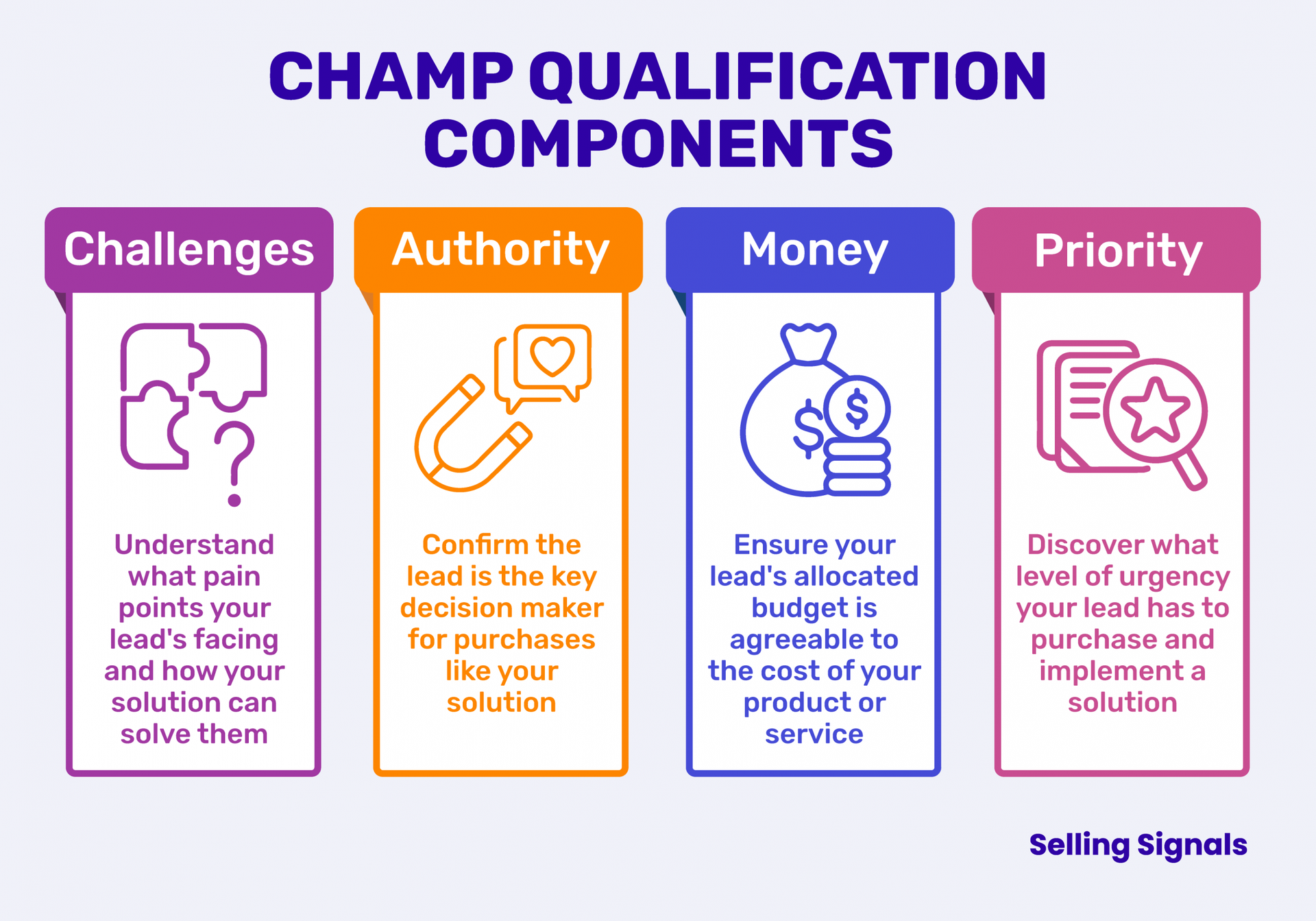
This framework digs a bit deeper by looking at the specific problems your lead faces:
- Challenges: What issues are they dealing with that your product can fix?
- Authority: Are you speaking with the right person?
- Money: Do they have the budget for it?
- Priorities: How urgent is this for them?
CHAMP is a solid choice for leads with clear pain points.
It helps you understand whether your product is what they need, but it works best if you already have some insight into their specific challenges.
Lead qualification using MEDDIC
MEDDIC is a more detailed lead-qualification framework, perfect for big deals with many decision-makers.
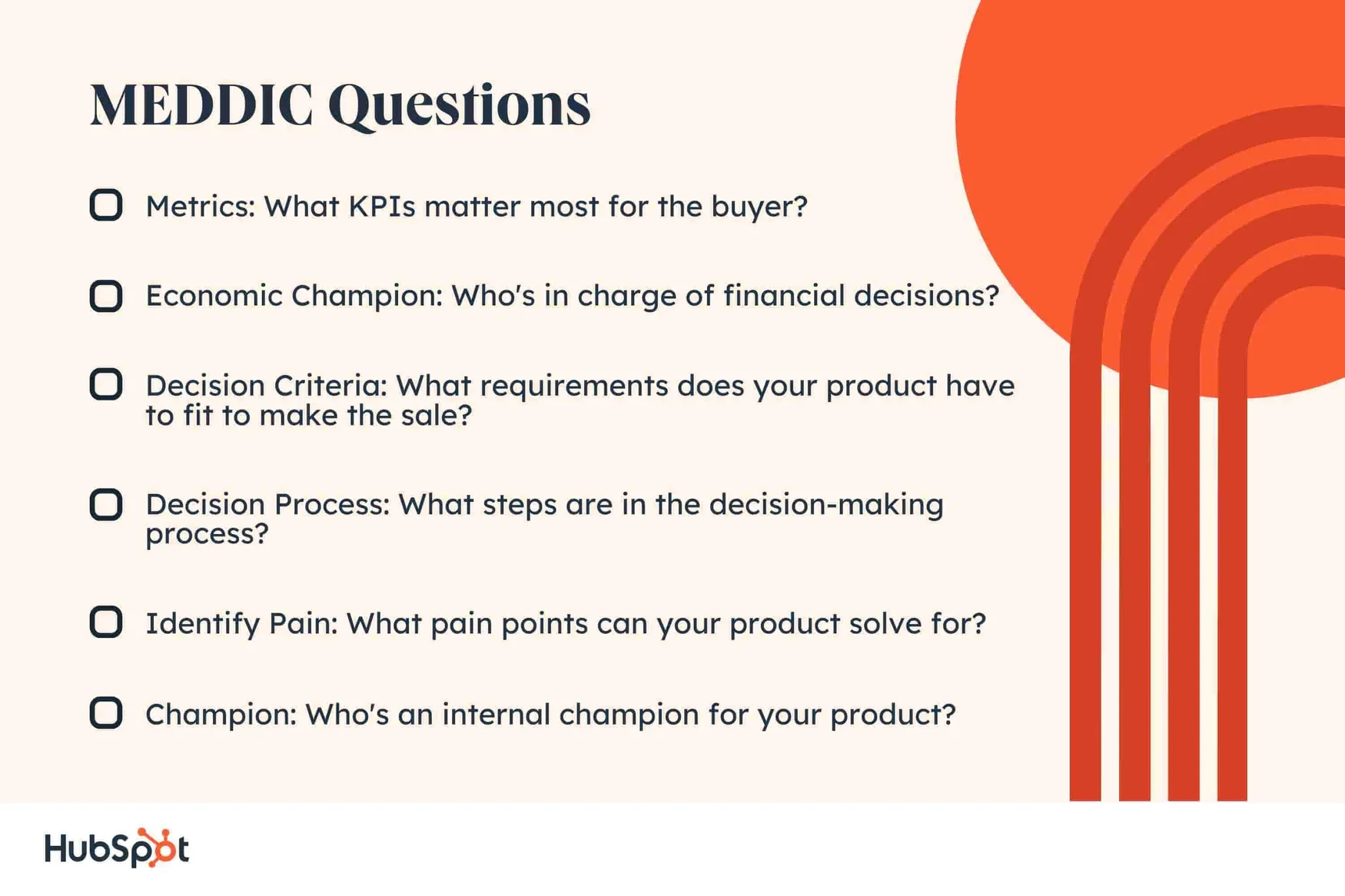
Here’s what it stands for:
- Metrics: What measurable results can they expect from your solution?
- Economic buyer: Are you in touch with the person who controls the budget?
- Decision criteria: What standards do they use to pick a solution?
- Decision process: How do they make purchasing decisions?
- Identify pain points: What’s driving their need for a solution?
- Champion: Do they have someone pushing for this on their side?
MEDDIC helps you get a full picture, which is perfect for big deals where you need to understand all the moving parts.
It’s thorough, but it might feel overkill if you deal with simpler, faster sales.
Lead qualification using GPCTBA/C&I
GPCTBA/C&I sounds complicated, but it’s worth it for tech and other industries where things are constantly shifting.
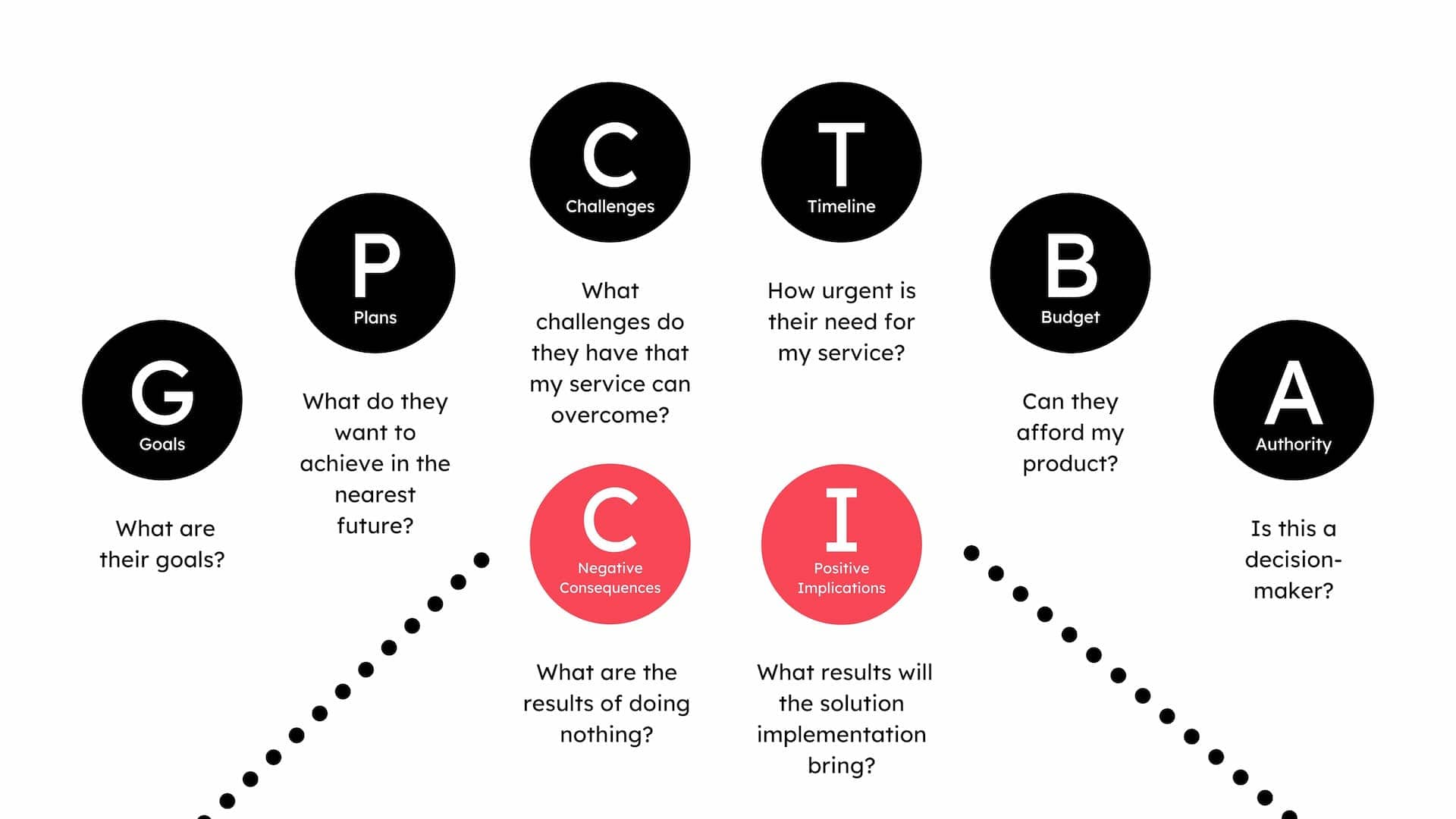
It stands for Goals, Plans, Challenges, Timeline, Budget, Authority, Consequences, and Implications:
- Goals: What are they trying to achieve?
- Plans: How do they plan to get there?
- Challenges: What’s standing in their way?
- Timeline: When do they need results?
- Budget: Do they have the funds to make this work?
- Authority: Who’s in charge of making this decision?
- Consequences: What happens if they don’t do anything?
- Implications: How will your solution impact their business?
GPCTBA/C&I covers both immediate needs and long-term goals, making it handy for complex sales where things change over time.
It gives you a full view, but you’ll probably need more time to walk through it all.
Lead qualification checklist for sales and marketing teams
This quick checklist will help you see if a lead is worth your team’s time and effort:
- Budget
- Does the lead have the budget to afford our product or service?
- Have they previously purchased similar products or services?
- Authority
- Are we engaging with a decision-maker or someone who can influence the buying process?
- Who else is involved in the decision-making process?
- Need
- What specific challenges or pain points is the lead facing?
- Does our product or service address their unique needs?
- Timing
- Is there a clear timeline for when they want to implement a solution?
- Are they looking to solve this issue immediately or in the future?
- Fit with product/service
- Does the lead fit our ideal customer profile (e.g., industry, company size, geographic location)?
- Are they familiar with solutions like ours, or is this a new concept for them?
- Urgency and motivation
- How motivated are they to solve this problem?
- What happens if they don’t address these challenges soon?
- Long-term potential
- Could this lead open doors to additional opportunities, such as upsells or referrals?
- Does this lead have a long-term need for our products or services?
- Competitive landscape
- Are they considering other solutions?
- What would make them choose us over competitors?
Conclusion
Lead qualification sharpens your focus on the right prospects, making your lead-generation process more efficient and productive.
With clear criteria and a structured approach, you’ll build a sales pipeline filled with high-quality leads.
Put these steps to work with PhantomBuster 14-day free trial and qualify sales leads faster!
